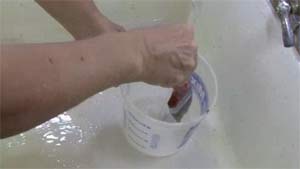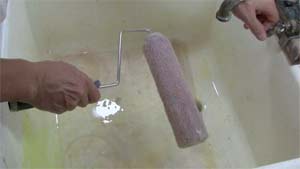How to Wash Paint Brushes and Rollers
by: Dale Cox
You can clean latex paint from brushes using a kitchen or bathroom sink but to wash rollers, you'll need a utility sink. The splatter that comes from a thorough cleaning of rollers will be too messy for the kitchen or bathroom. Check here for a video demonstrating how to wash a paint brush and
here for a demonstration of how to clean a paint roller.
Washing a Latex Paint Brush

Wash a brush by first scraping it on the side of the paint can to remove all the excess paint. In a sink, use a small plastic pail or food container to collect a couple of cups of warm water. Bounce the brush bristles against the bottom of the pail several times until the water is saturated with paint and then dump it out. Rinse the pail and collect a couple more cups of warm water. Bounce the brush several times in the fresh water and then dump it.
Repeat this process until the water remains clear when bouncing the brush. Shake all the water from brush bristles by spinning the handle back and forth between your palms or hitting the handle against the upturned toe of your shoe several times to throw the excess water off. Stand the brush with the bristles pointing up in the pail until it dries. When you're ready to paint again, flex the bristles back and forth in your hand a few times to soften them.
Washing Oil Brushes
It's best for the environment and your health if you can avoid using oil paint at all. If you must however, cleaning the brush won't be easy. One option is to use chip brushes for oil coating whenever possible. A chip brush will usually not suffice for fine work like painting trim molding but if you have a porch floor or decking to paint, a cheap, disposable brush can be the best choice.
To wash an oil brush, scrape all the excess paint from the bristles first and then use a solvent like mineral spirits to clean the bristles. If you have more than one oil brush to clean, doing them all at once will save a lot of effort and resources. If you don't need to use the brush again right away, soak it for 2 or 3 days before trying to wash it completely. This can greatly reduce the amount of solvent need to clean an oil brush. To soak, use a small paint pail and place all the brushes in it pointing down. Pour in enough solvent to cover the bristles and overlap onto the ferrule (the metal band holding the bristles to the handle) a bit. Let the pail sit in a safe place for several days. The longer, the better.
When you're ready to wash the brush, bounce the bristles a couple times in the solvent soak before removing it. Pour the used mineral spirits into a re-sealable container like a gallon jug to save it. Rinse the pail clean with a bit of fresh mineral spirits and pour that into your jug too.
Working with one brush at a time, pour a small amount of solvent into the pail and bounce the bristles in it several times. Pull the bristle out and spin the handle between your palms a few times to throw off the excess liquid and set the brush aside. Repeat this with each brush using the same bit of solvent before pouring it off into your jug. It's a good idea to work backwards when you have several brushes to wash so the last one out is the first one into a fresh batch of solvent.
Repeat this process using fresh solvent each time until no more paint comes from the bristles. This can take many repeated cycles to get a completely clean oil brush. This is particularly true when washing several brushes at once. When the solvent remains clear and no more paint comes from the bristles, wrap them in newspaper and place the brush in a plastic bag to contain the fumes. Keep the jug of used mineral spirits in a safe place and let it stand undisturbed for several weeks. The paint will settle to the bottom of the jug leaving the solvent clean and ready to use again.
Washing a Paint Roller

If you use a roller for oil paint, it's best to just throw it out when you're done. The cost of solvent alone, not to mention the mess to clean a roller used for oil paint would outweigh the cost of buying a new one.
To clean latex paint from a roller, first scrape all the excess paint from the nap using the side of putty knife. Remove the roller from the arm and slip it onto a roller spinner. Hold the roller under a stream of warm water until the nap is saturated. Hold the roller vertically and spin it so the water is thrown against the sides of a deep utility sink. Saturate the nap with water and spin it out again. Repeat this until the water coming from the roller is clear.
Pull the roller off the spinner and set it on edge on a piece of newspaper or a paper towel to dry. Washing your paint rollers in this way will help them last through many paint jobs.
Brush Restorer for Latex Brushes
If you don't clean your latex brushes thoroughly, you will probably have a buildup of dry paint in the bristles near the ferrule making the brush very stiff and hard to use. After several occasions of letting paint dry in the brush like this, the bristles will become too stiff to be usable at all. This can become very expensive if you do a lot of painting and use professional-quality brushes. It may be possible to restore your abused brushes using the process described below.
Set the brush bristles down in a plastic paint bucket. Add hot water to fill the bucket to just over the ferrule. Pour in a cup of liquid laundry detergent and turn the brush back and forth gently a couple times to agitate. Let the brush sit in the water for three days, agitating a couple of times a day. At the end of the three days, pour off the soapy water and wash the brush as described above. Set the brush with the bristles pointing up to dry. If this doesn't do the trick, try soaking the brush again for another three days.